Epidemic of Wheat Stripe Rust Detected by Hyperspectral Remote Sensing and Its Potential Correlation with Soil Nitrogen during Latent Period
Abstract
1. Introduction
2. Materials and Methods
2.1. Experimental Material
2.2. Experimental Designs
2.3. Hyperspectral Data Acquisition and Preprocessing
2.4. Pst Detection by Duplex Real-Time PCR during Latent Period
2.5. Field Disease Index Acquisition
2.6. Recognition Model
3. Results
3.1. Wheat Canopy Spectra
3.2. Correlation between MDI and DI
3.3. WSR Recognition with Hyperspectral Features in the 325–1075 nm Waveband
3.4. WSR Recognition with Hyperspectral Features in the Sub-Waveband Range
3.4.1. Recognition Results of the DPLS Model in 2016–2017
3.4.2. Recognition Results of SVM Model in 2016–2017
3.4.3. Recognition Results of DPLS Model in 2017–2018
3.4.4. Recognition Results of SVM Model in 2017–2018
3.5. Correlation between Soil Nitrogen Nutrition and WSR Severity
4. Discussion
4.1. Recognition of Wheat Stripe Rust with Hyperspectral Remote Sensing
4.2. Correlation between Soil Nitrogen Nutrition and WSR Severity
5. Conclusions
- In the 325–1075 nm waveband, the average recognition accuracy of the model built by SVM was better than that using DPLS. The average accuracy of the model built by the first type of spectral feature was better than the model using the second type of spectral feature. The average accuracy values of the DPLS and SVM methods were 75–80%, and the accuracy of the best-performing model was between 80–85%.
- In the sub-wavebands, the models built based on the DPLS method with the best accuracy in two years were all concentrated in the 325–474 nm range using the original spectrum (R) as the spectral character. The models built based on the SVM method with the best recognition accuracy in the two years were concentrated in the 475–624 nm range using the first derivative of the pseudo absorption coefficient (log10(1/R)_1st.dv) as the spectral feature.
- There was a significant positive correlation between wheat stripe rust and soil nitrogen nutrients during latent period and symptom period, which also provided the theoretical basis for more accurate remote sensing monitoring on the wheat stripe rust.
Author Contributions
Funding
Institutional Review Board Statement
Informed Consent Statement
Data Availability Statement
Conflicts of Interest
References
- Porter, J.R.; Xie, L.; Challinor, A.J.; Cochrane, K.; Howden, S.M.; Iqbal, M.M.; Lobell, D.B.; Travasso, M.I. Chapter 7. Food Security and Food Production Systems. Climate Change 2014: Impacts, Adaptation and Vulnerability. In Working Group II Contribution to the IPCC 5th Assessment Report; IPCC Secretariat: Geneva, Switzerland, 2014; pp. 488–489. [Google Scholar]
- Prank, M.; Kenaley, S.C.; Bergstrom, G.C.; Acevedo, M.; Mahowald, N.M. Climate change impacts the spread potential of wheat stem rust, a significant crop disease. Environ. Res. Lett. 2019, 14, 124053. [Google Scholar] [CrossRef]
- Juroszek, P.; Racca, P.; Link, S.; Farhumand, J.; Kleinhenz, B. Overview on the review articles published during the past 30 years relating to the potential climate change effects on plant pathogens and crop disease risks. Plant Pathol. 2020, 69, 179–193. [Google Scholar] [CrossRef]
- De, W.E.; Isard, S.A. Disease Cycle Approach to Plant Disease Prediction. Annu. Rev. Phytopathol. 2007, 45, 203–220. [Google Scholar]
- Garrett, K.A.; Nita, M.; Wolf, E.; Gomez, L.; Sparks, A.H. Plant pathogens as indicators of climate change. In Climate Change; Elsevier: Amsterdam, The Netherlands, 2009; pp. 425–437. [Google Scholar]
- Luo, C.; Ma, L.; Zhu, J.; Guo, Z.; Dong, K.; Dong, Y. Effects of Nitrogen and Intercropping on the Occurrence of Wheat Powdery Mildew and Stripe Rust and the Relationship With Crop Yield. Front. Plant Sci. 2021, 12, 637393. [Google Scholar] [CrossRef]
- Snoeijers, S.S.; Pérez, G.A.; Joosten, M.; De Wit, P.J.G.M. The Effect of Nitrogen on Disease Development and Gene Expression in Bacterial and Fungal Plant Pathogens. Eur. J. Plant Pathol. 2000, 106, 493–506. [Google Scholar] [CrossRef]
- Devadas, R.; Simpfendorfer, S.; Backhouse, D.; Lamb, D.W. Effect of stripe rust on the yield response of wheat to nitrogen. Crop J. 2014, 2, 201–206. [Google Scholar] [CrossRef]
- Hovmøller, M.S.; Walter, S.; Justesen, A.F. Escalating threat of wheat rusts. Science 2010, 329, 329–369. [Google Scholar] [CrossRef]
- Enjalbert, J.; Duan, X.; Giraud, T.; Vautrin, D.; De Vallavieille-Pope, C.; Solignac, M. Isolation of twelve microsatellite loci, using an enrichment protocol, in the phytopathogenic fungus Puccinia striiformis f. sp. tritici. Mol. Ecol. Notes 2002, 2, 563–565. [Google Scholar] [CrossRef]
- Boyd, L.A. Can Robigus defeat an old enemy? Yellow rust of wheat. J. Agric. Sci. 2005, 143, 233–243. [Google Scholar] [CrossRef]
- Chen, X.M. Epidemiology and control of stripe rust (Puccinia striiformis f.sp. tritici) on wheat. J. Plant Pathol. 2005, 27, 314–337. [Google Scholar]
- Hu, X.; Cao, S.; Xu, X. Predicting overwintering of wheat stripe rust in central and north-western China. Plant Dis. 2020, 104, 44–51. [Google Scholar] [CrossRef]
- Zeng, S.M.; Luo, Y. Long-distance spread and interregional epidemics of wheat stripe rust in China. Plant Dis. 2006, 90, 980–988. [Google Scholar] [CrossRef] [PubMed]
- Wang, H.Z.; Li, S.J.; Huo, Z.R.; Pang, J.A. Physiological changes of cucumber after being infected by Sphaerotheca fuliginea. Acta Agric. Boreali-Sin. 2006, 21, 105–109. [Google Scholar]
- Wan, A.M.; Chen, X.M.; He, Z.H. Wheat stripe rust in China. Aust. J. Agric. Res. 2007, 58, 605–619. [Google Scholar] [CrossRef]
- Fan, H.Z.; Pei, W.Y. A preliminary investigation on the affecting factors and disease management of rice yellow stunt disease in Kwangtung. J. South China Agric. Coll. 1980, 1, 1–15. [Google Scholar]
- Segarra, J.; Jeger, M.J. Epidemic dynamics and patterns of plant diseases. Phytopathology 2001, 91, 1001–1010. [Google Scholar] [CrossRef]
- Guo, A.; Huang, W.; Ye, H.; Dong, Y.; Ma, H.; Ren, Y.; Ruan, C. Identification of Wheat Yellow Rust using Spectral and Texture Features of Hyperspectral Images. Remote Sens. 2020, 12, 1419. [Google Scholar] [CrossRef]
- Dehkordi, R.H.; Jarroudi, M.E.; Kouadio, L.; Meersmans, J.; Beyer, M. Monitoring Wheat Leaf Rust and Stripe Rust in Winter Wheat Using High-Resolution UAV-Based Red-Green-Blue Imagery. Remote Sens. 2020, 12, 3696. [Google Scholar] [CrossRef]
- Wu, Q.; Wang, J.H.; Wang, C.; Ma, Z.H. Recognition of wheat pre-harvest sprouting based on hyperspectral imaging. Opt. Eng. 2012, 51, 111710. [Google Scholar] [CrossRef]
- Liu, H.J.; Brooke, B.; Trevor, G.; Bettina, B. The Performances of Hyperspectral Sensors for Proximal Sensing of Nitrogen Levels in Wheat. Sensors 2020, 20, 4550. [Google Scholar] [CrossRef]
- Liu, Q.; Li, W.; Wang, C.; Gu, Y.; Wang, R.; Ma, Z. Qualitative identification of canopy spectra in wheat stripe rust based on Logistic, IBk and Random committee methods. J. Plant Prot. 2018, 45, 146–152. [Google Scholar]
- Liu, Q.; Gu, Y.; Wang, C.; Wang, R.; Li, W.; Ma, Z. Canopy hyperspectral features analysis of latent period wheat stripe rust based on discriminant partial least squares. J. Plant Prot. 2018, 45, 138–145. [Google Scholar]
- Golhani, K.; Balasundram, S.K.; Vadamalai, G.; Pradhan, B. A review of neural networks in plant disease detection using hyperspectral data. Inf. Processing Agric. 2018, 5, 354–371. [Google Scholar] [CrossRef]
- Zhang, N.; Yang, G.; Pan, Y.; Yang, X.; Chen, L.; Zhao, C. A review of advanced technologies and development for hyperspectral-based plant disease detection in the past three decades. Remote Sens. 2020, 12, 3188. [Google Scholar] [CrossRef]
- Yan, J.H.; Luo, Y.; Pan, J.J.; Wang, H. Quantification of latent infection of wheat stripe rust in the fields using real-time PCR. Acta Phytopathol. Sin. 2011, 41, 618–625. [Google Scholar]
- Bock, C.H.; Poole, G.H.; Parker, P.E.; Gottwald, T.R. Plant disease severity estimated visually, by digital photography and image analysis, and by hyperspectral imaging. Crit. Rev. Plant Sci. 2010, 29, 59–107. [Google Scholar] [CrossRef]
- Demetriades Shah, T.H.; Steven, M.D.; Clark, J.A. High resolution derivative spectra in remote sensing. Remote Sens. Environ. 1990, 33, 55–64. [Google Scholar] [CrossRef]
- Serrano, L.; Penuelas, J.; Ustin, S.L. Remote sensing of nitrogen and lignin in Mediterranean vegetation from AVIRWAS data: Decomposing biochemical from structural signals. Remote Sens. Environ. 2002, 81, 355–364. [Google Scholar] [CrossRef]
- Wang, J.H.; Zhao, C.J.; Huang, W.J. The Application of Agricultural Quantitative Remote Sensing; Science Press: Beijing, China, 2008. [Google Scholar]
- Wang, H.; Qin, F.; Ruan, L.; Wang, R.; Liu, Q.; Ma, Z.; Li, X.; Cheng, P.; Wang, H. Identification and Severity Determination of Wheat Stripe Rust and Wheat Leaf Rust Based on Hyperspectral Data Acquired Using a Black-Paper-Based Measuring Method. PLoS ONE 2016, 11, e0154648. [Google Scholar] [CrossRef]
- Rogers, S.O.; Bendich, A.J. Extraction of DNA from milligram amount of fresh herbarium and mummified plant tissues. Plant Mol. Biol. 1985, 5, 69–76. [Google Scholar] [CrossRef]
- Pan, Y.; Gu, Y.L.; Luo, Y.; Ma, Z. Establishment and application of duplex real-time PCR quantitative determination method on latent infection of wheat stripe rust. Acta Phytopathol. Sin. 2016, 46, 485–491. [Google Scholar]
- Zhao, J.; Wang, X.J.; Chen, C.Q.; Huang, L.L.; Kang, Z.S. A PCR-based assay for detection of Puccinia striiformis f. sp. Tritici in wheat. Plant Dis. 2007, 91, 1669–1674. [Google Scholar] [CrossRef] [PubMed][Green Version]
- Sandberg, M.; Lundberg, L.; Ferm, M.; Yman, I.M. Real time PCR for the detection and discrimination of cereal contamination in gluten free foods. Eur. Food Res. Technol. 2003, 217, 344–349. [Google Scholar] [CrossRef]
- Simón, M.R.; Cordo, C.A.; Perelló, A.E.; Struik, P.C. Influence of nitrogen supply on the susceptibility of wheat to Septoria tritici. J. Phytopathol. 2003, 151, 283–289. [Google Scholar] [CrossRef]
- Penuelas, J.; Bweret, F.; Filella, I. Semiempirical indexes to assess carotenoids chlorophyll-a ratio from leaf spectral reflectance. Photosynthetica 1995, 31, 221–230. [Google Scholar]
- Qin, H.; Wang, H.R.; Li, W.J.; Jin, X.X. Application of DPLS-based LDA in corn qualitative near infrared spectroscopy analysis. Spectrosc. Spectr. Anal. 2011, 31, 1777–1781. [Google Scholar]
- Vapnik, V.N. An overview of statistical learning theory. IEEE Trans. Neural Netw. 1999, 10, 988–999. [Google Scholar] [CrossRef]
- Li, J.; Chen, Y.; Jiang, J. Using Hyperspectral Derivative Index to Identify Winter Wheat Stripe Rust Disease. Sci. Technol. Rev. 2007, 25, 23–26. [Google Scholar]
- Liu, Q.; Gu, Y.; Wang, S.; Wang, C.; Ma, Z. Canopy Spectral Characterization of Wheat Stripe Rust in Latent Period. J. Spectrosc. 2015, 2015, 1–11. [Google Scholar] [CrossRef]
- Xiao, J.X.; Zheng, Y. Nutrients uptake and pests and diseases control of crops in intercropping system. Chin. Agric. Sci. Bull. 2005, 21, 150–154. [Google Scholar]
- Devadas, R.; Lamb, D.W.; Backhouse, D.; Simpfendorfer, S. Sequential application of hyperspectral indices for delineation of stripe rust infection and nitrogen deficiency in wheat. Precis. Agric. 2015, 16, 477–491. [Google Scholar] [CrossRef]
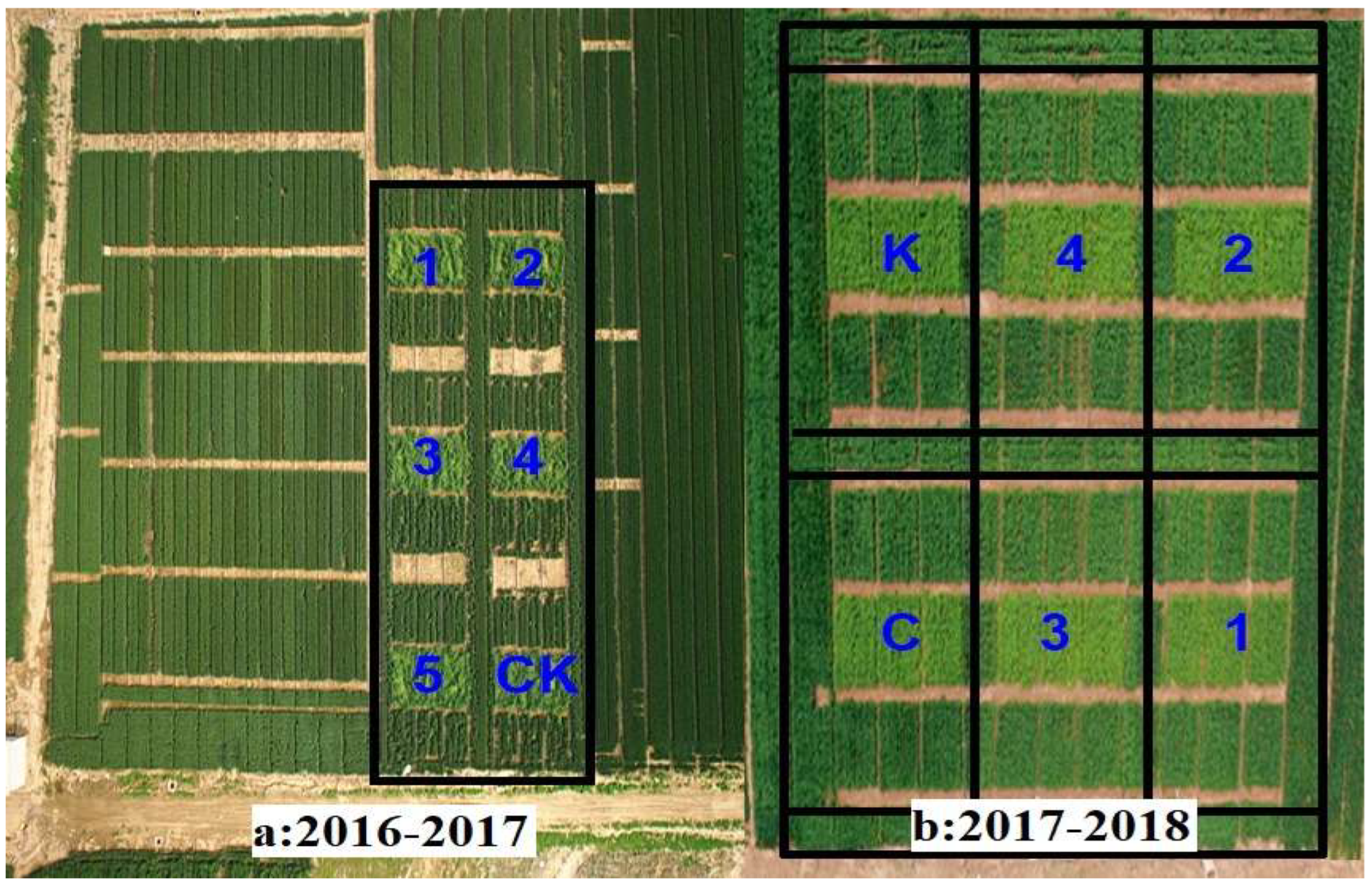
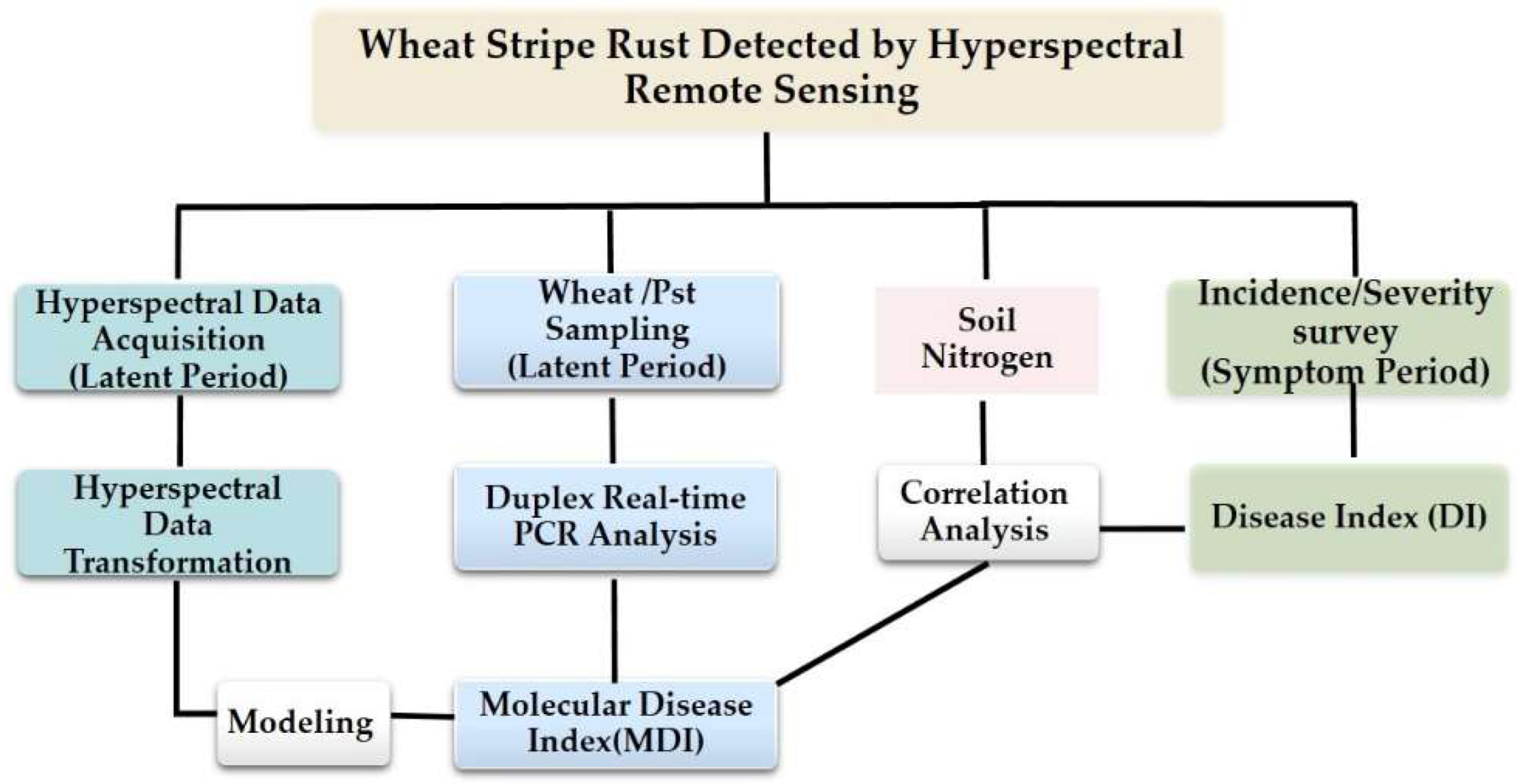
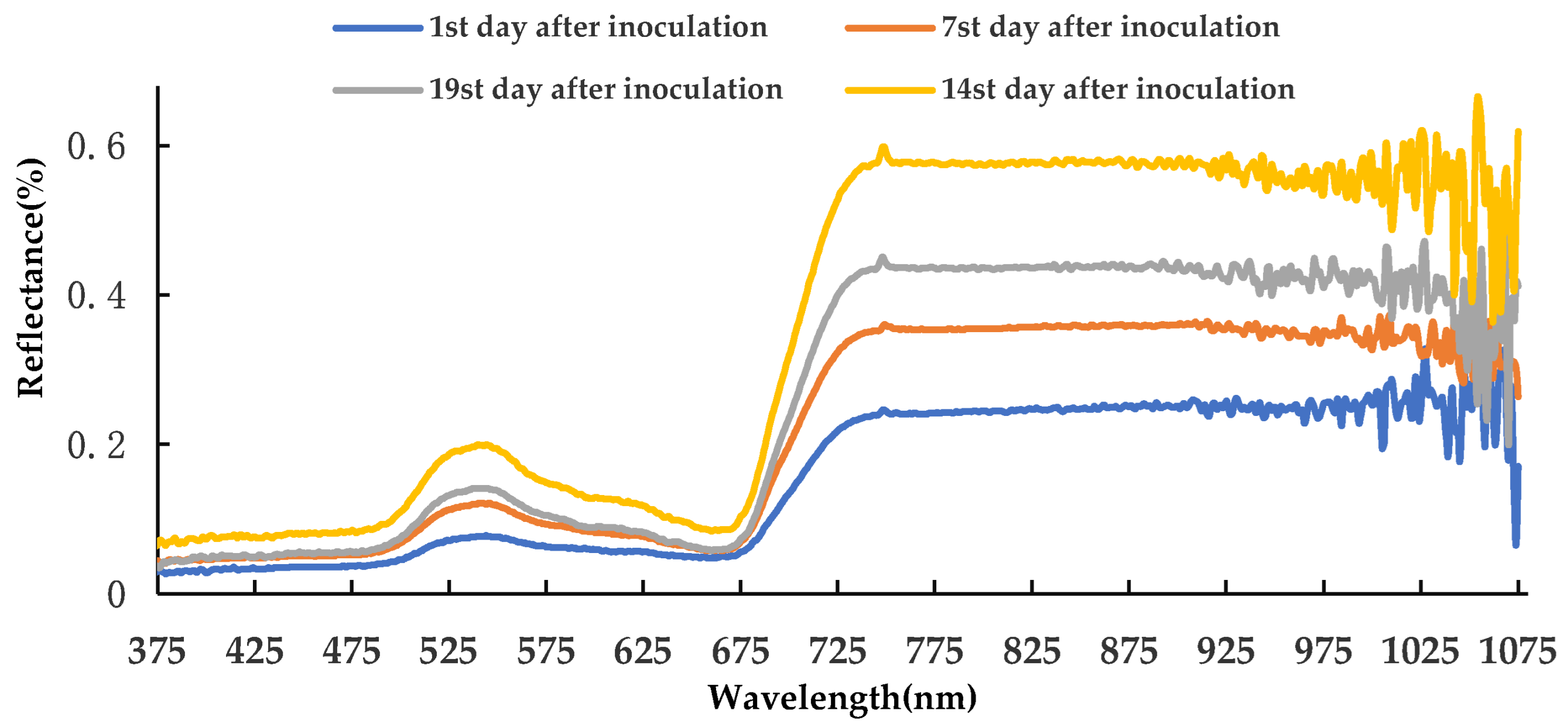
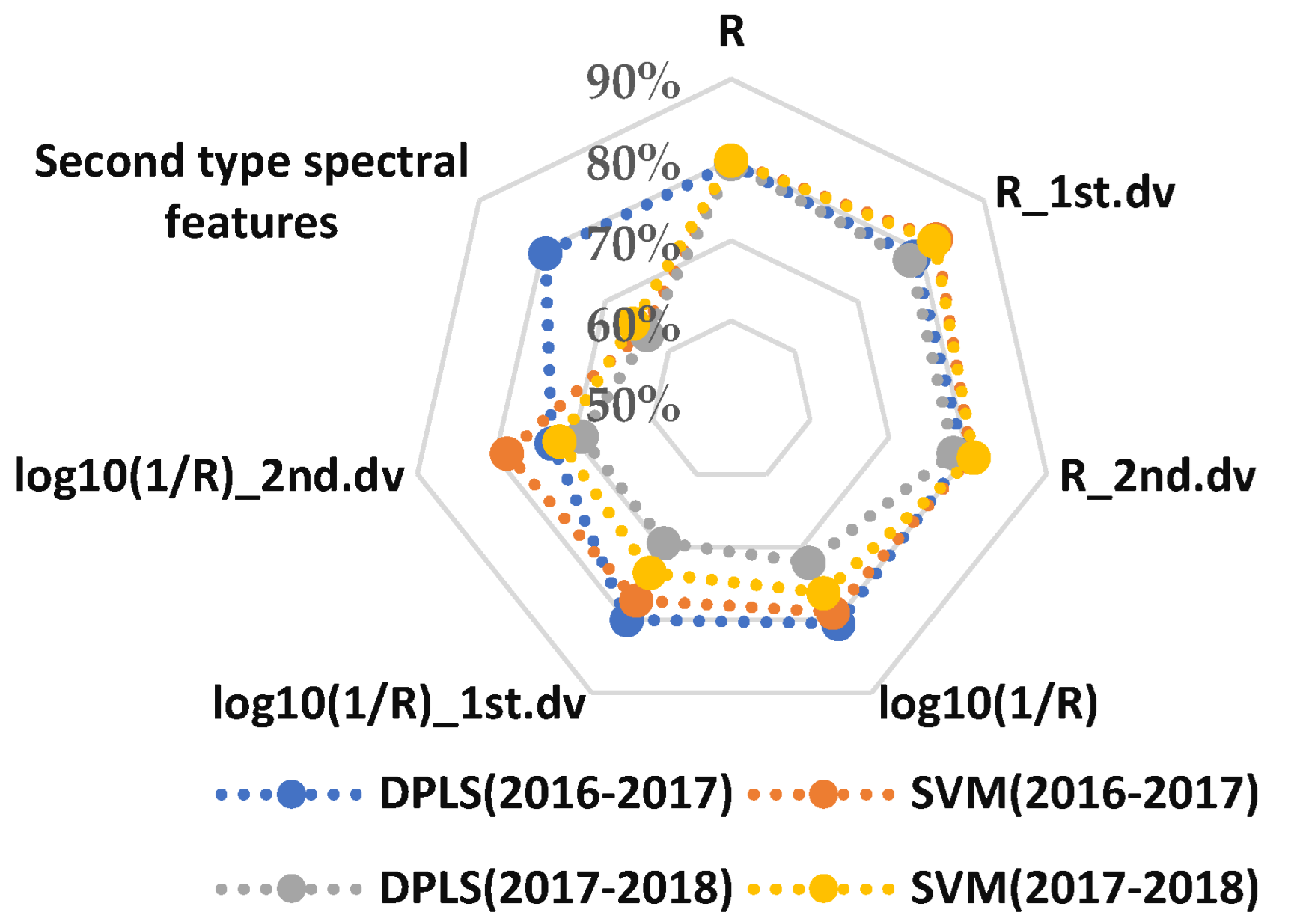


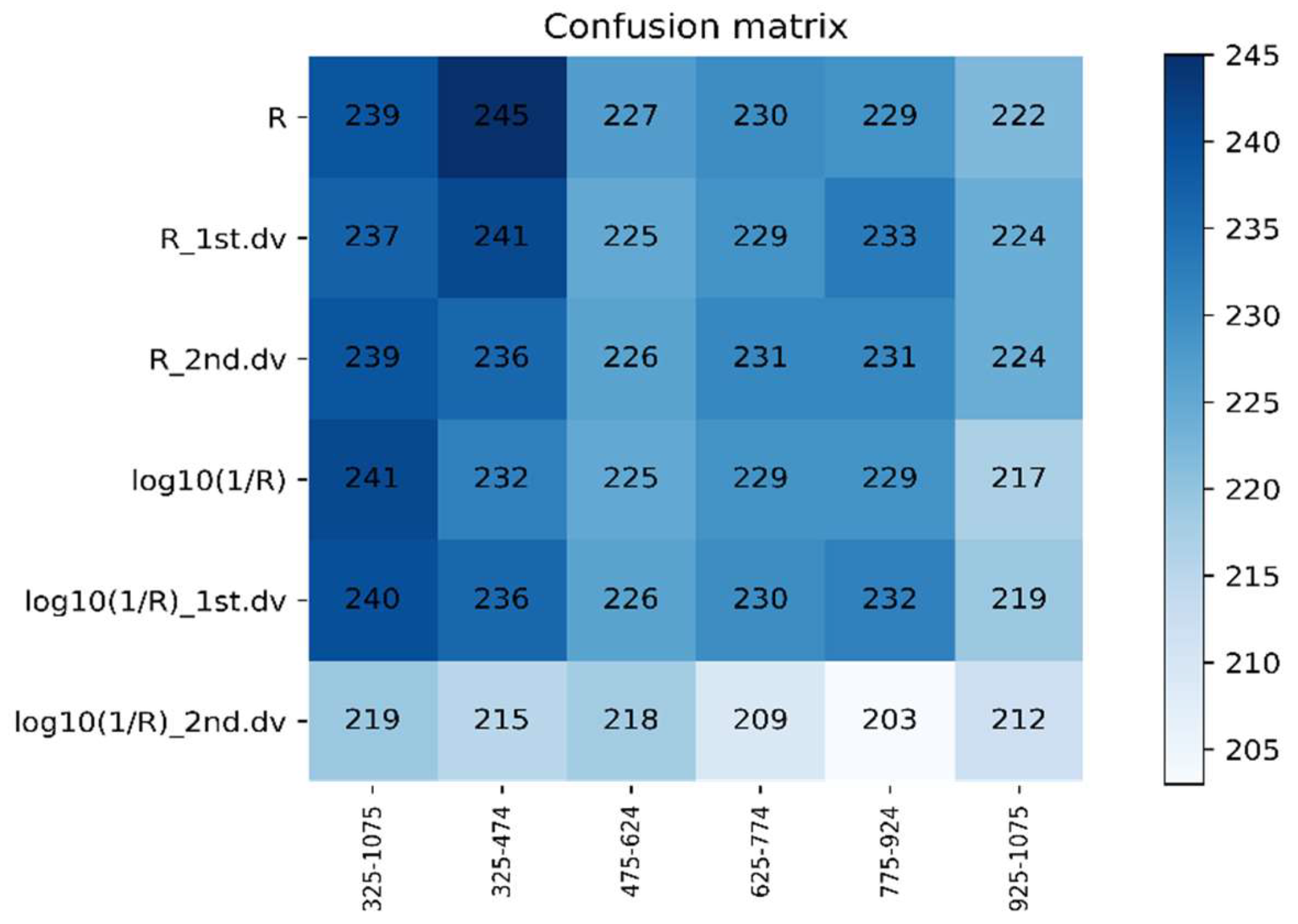






| Year | Correlation Coefficient | Significance Level | Regression Equation | R2 | Root Mean Square Error |
|---|---|---|---|---|---|
| 2016–2017 | 0.84840 | <0.0001 | y = 0.0415 + 11.973X | 0.7198 | 0.1221 |
| 2017–2018 | 0.90056 | <0.0001 | y = 0.6176 + 6.4193X | 0.8110 | 3.1608 |
| Year | Spectral Features | The Ratio of the Training Set to Testing Set | The Principal Component Number | Accuracy | F1 Score | Matthews Correlation Coefficient |
|---|---|---|---|---|---|---|
| 2016–2017 | log10(1/R) | 4: 1 4: 1 | 30 | 84.57 | 84.21 | 82.75 |
| 2017–2018 | R | 30 | 82.29 | 81.82 | 80.84 |
| Year | Spectral Features | The Ratio of the Training Set to Testing Set | Optimal Parameter | Accuracy | F1 Score | Matthews Correlation Coefficient | |
|---|---|---|---|---|---|---|---|
| Best c | Best g | ||||||
| 2016–2017 | R_1st.dv | 3: 1 | 6.9644 | 64 | 83.17 | 83.15 | 82.23 |
| 2017–2018 | R_1st.dv | 4: 1 | 2.2974 | 64 | 84.03 | 83.65 | 82.19 |
| Growth Stage | Inoculation Concentration (mg/L) | Mingxian169 Disease Index | Beijing0045 Disease Index | Nongda195 Disease Index |
|---|---|---|---|---|
| Latent | 80 | 0.916 ** | 0.574 | 0.517 |
| Period | 40 | 0.922 ** | 0.493 | 0.513 |
| 20 | 0.801 * | 0.354 | 0.487 | |
| 10 | 0.599 | 0.277 | 0.101 | |
| Symptom | 80 | 0.982 ** | 0.673 | 0.599 |
| Period | 40 | 0.895 ** | 0.54 | 0.466 |
| 20 | 0.838 * | 0.13 | 0.084 | |
| 10 | 0.711 | 0.063 | 0.058 |
Publisher’s Note: MDPI stays neutral with regard to jurisdictional claims in published maps and institutional affiliations. |
© 2022 by the authors. Licensee MDPI, Basel, Switzerland. This article is an open access article distributed under the terms and conditions of the Creative Commons Attribution (CC BY) license (https://creativecommons.org/licenses/by/4.0/).
Share and Cite
Chen, J.; Saimi, A.; Zhang, M.; Liu, Q.; Ma, Z. Epidemic of Wheat Stripe Rust Detected by Hyperspectral Remote Sensing and Its Potential Correlation with Soil Nitrogen during Latent Period. Life 2022, 12, 1377. https://doi.org/10.3390/life12091377
Chen J, Saimi A, Zhang M, Liu Q, Ma Z. Epidemic of Wheat Stripe Rust Detected by Hyperspectral Remote Sensing and Its Potential Correlation with Soil Nitrogen during Latent Period. Life. 2022; 12(9):1377. https://doi.org/10.3390/life12091377
Chicago/Turabian StyleChen, Jing, Ainisai Saimi, Minghao Zhang, Qi Liu, and Zhanhong Ma. 2022. "Epidemic of Wheat Stripe Rust Detected by Hyperspectral Remote Sensing and Its Potential Correlation with Soil Nitrogen during Latent Period" Life 12, no. 9: 1377. https://doi.org/10.3390/life12091377
APA StyleChen, J., Saimi, A., Zhang, M., Liu, Q., & Ma, Z. (2022). Epidemic of Wheat Stripe Rust Detected by Hyperspectral Remote Sensing and Its Potential Correlation with Soil Nitrogen during Latent Period. Life, 12(9), 1377. https://doi.org/10.3390/life12091377







